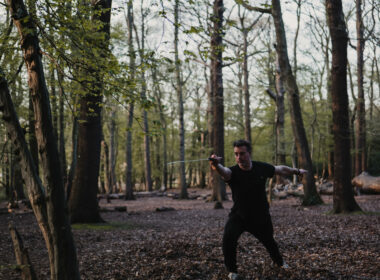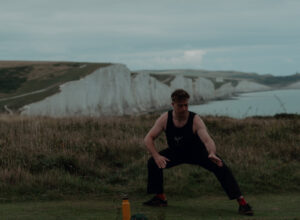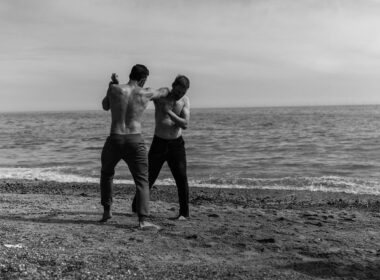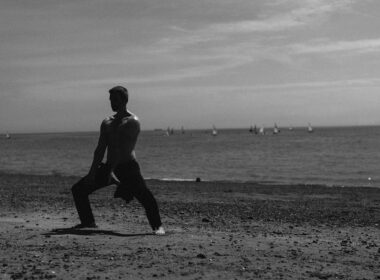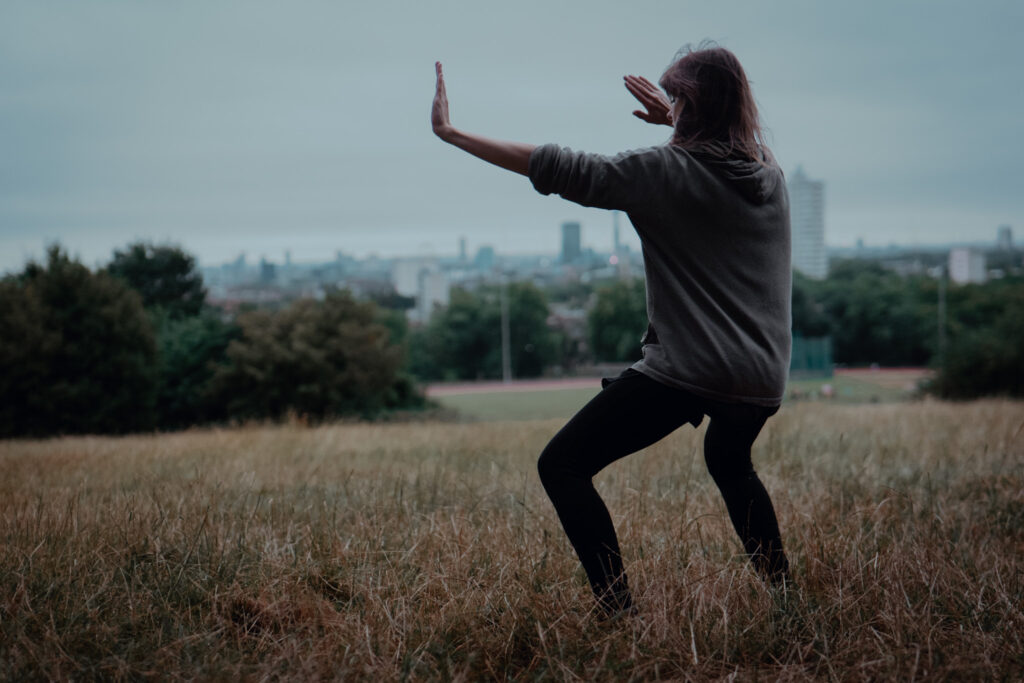Tai Chi Chuan The Art of Overcoming Hardness with Softness
a) The Problem
The theory of Yin and Yang has taught us that hardness can overcome softness and that softness can overcome hardness. Let us now see how this theory works in practice when applied to Chinese martial arts.
A common occurrence in martial arts would be where A attacks B with all his strength and B uses all his strength to block the attack. Here the parties are engaged in a battle of force against force and the stronger side will win.
In another typical situation let us suppose that two men, one weak, the other strong, go to the same martial arts school and learn the same techniques for an equal length of time. In a fight between the two, the stronger will still defeat the weaker.
Wang Chung Yueh, a Tai Chi Chuan master, who lived during the Ming Dynasty, studied this type of situation. After many years of observing various hard styles of the Chinese martial arts, he came to the conclusion that, stylistic differences aside, when used in combat the end result was always the same; victory would go to the swiftest and strongest, and not necessarily to those who had made an intensive study of their art.
Chang San Feng had studied the same situation, even before Wang did. Driven by a belief that victory need not inevitably go to the strong, but that brain could defeat brawn, he used his knowledge of Taoism to create a martial art based on the principles of Tai Chi – the changes of Yin and Yang. He called it Tai Chi Chuan, the word ‘Chuan’ meaning ‘Fist’ and thus representing martial art.
Correct application of Tai Chi Chuan techniques in combat will result in the situation where a slight application of force is sufficient to deflect, divert, or otherwise render harmless a force which is many times greater in magnitude. Thus the soft overcomes the hard and the weak need not fear to do battle with the strong. For the purposes of Tai Chi Chuan in combat, softness is the use of intelligent tactics, and is not merely a weak force which can somehow magically defeat a stronger one.
The two major principles of Tai Chi Chuan self-defence strategy are using stillness to defeat motion, and using softness to defeat hardness.
b) The Solution Part One: Stillness defeats Motion
The practice of this principle requires a clear mind. We should wait for our opponent to begin making the first move then ‘pre-empt’ him by reacting decisively before he can complete it. We do this because, when first facing our opponent, we do not know his intentions, and so we do not know which part of our body he will attack. It is better, then, to wait until he commits himself to an attack so that we can divert it before it reaches its conclusion, and then we in turn can counterattack by striking his weak points.
We must avoid taking this principle to the absurd conclusion of waiting for our opponent to hit us without moving a muscle in response. That is why in a classical text on the Thirteen Tactics it is written, ‘If the enemy does not move, we do not move, but as soon as he begins to move we move at once.’
In using this principle, our mind must remain clear to enable us to detect our opponent’s slightest movements and to counteract any intended attack. The key to this principle is that once our opponent has committed himself to an attack it is already too late for him to react to our counteraction. In the words of the military strategist Sun Tzu, ‘We must know ourselves and our opponent.’ We can only do this by remaining calm and collected until we clearly detect an impending attack to which we then immediately respond.
c) The Solution Part Two: Softness overcomes Hardness
In the practice of this principle we must consciously avoid using brute force in attempting to counteract the attacks of our opponent. Mind and body must work in harmony in the correct application of the techniques of defence and counterattack.
The idea is to divert the attacks of our opponent in such a way as to turn his own force against him. This requires the use of one or more of the Eight Powers (八勁)of Tai Chi Chuan, which are discussed below. Thus, if our opponent tries to punch us in the chest, the use of ‘Li’ ,a slight diversion to the side, will be enough to divert even his strongest attack and pave the way for our counterattack. In the classical text of Tai Chi Pushing Hands it is written, ‘A force of four ounces can overcome a force of a thousand pounds.’
Constant practice with a partner over a period of years is necessary to develop the ability to apply this sophisticated concept to self-defence. Even then we still require tuition from a competent instructor. To put this in simple terms, most of us are aware that an ox can be led with a length of sting. Let us take the string to represent the four ounces and the ox to represent a thousand pounds. If the string is tied to a ring on the end of the ox’s nose it can easily be led, but if it is tied to its hind leg a different result can be anticipated.
The value then of a competent instructor is to teach the correct application of softness, or slight force. The use of hard force has certain clear cut disadvantages, even forthe mighty among us. It requires a greater expenditure of energy, whether used in defence or attack. This affects our breathing and increases our heartbeat which in turn puts a strain on our central nervous system, thus indirectly slowing our actions and reflexes. All this is of course very much to the advantage of our opponent. The use of softness on the other hand requires the expenditure of very little energy; our muscles remain relaxed and supple making our actions swift and sure. It also serves to develop clarity of thought and sensitivity, and to reduce stress. The net result is that when using this softness in combat against a ‘hard’ opponent, whether in hand or body contact with him, our body acts as a radar system, feeding us information about our opponent’s intentions, which his own hardness or tension allows our softness or sensitivity to detect.
The other disadvantage in relying on strength alone is that there is always someone stronger. It should also be recognised that even the strong get old some day
Strategy of the Five Step Path
Before being able to apply the tactics of Tai Chi Chuan in combat, we must first understand the strategy which governs their use. In the Song of Tai Chi Pushing Hands it is written ‘a force of only four ounces can overcome a force of one thousand pounds’.
This approach means that we must rely on skill and intellect rather than brute force; it also requires us to follow a set path of five principles:-
Adherence
Spontaneity
Softness
Yielding
Rejection of Brute Force
a) Adherence
implies that we must maintain contact with our opponent, remaining sensitive to his every action. Thus we are able to detect his attacks and sense his weak points.
b) Spontaneity
implies that our reactions to any attack should follow the principle that as soon as our opponent moves (attacks) we move (counter) before he can complete his movement. Defence and counter-attack are a series of smooth, unbroken movements.
c) Softness
implies that, when applying the principle of adherence, we should maintain only a soft or relaxed contact with our opponent. The sensitivity thus developed enables us to detect any changes in our opponent’s intentions. It is an early warning system. Our softness also makes it difficult for our opponent to detect our own intentions.
d) Yielding
implies that once we have detected the direction of our opponent’s force we must go with it, not against it. This is the key to the Tai Chi Chuan tactic of using ‘four ounces of force’ to divert even the fiercest attack to the void. While our opponent is using all his energy to attack us we are able to conserve ours.
e) Rejection
of Brute Force implies that arm contact with our opponent must be both soft and continuous. We must neither withdraw our arm nor let it become tense. This constant soft contact enables us to detect change and to make a spontaneous response without unnecessarily wasting energy. By adopting the strategy of the Five Step Path we are able to achieve the ideal of using the minimum effort necessary to produce the maximum effect.
To sum up, we must intercept any attack in a relaxed manner, adhering to it while we use only the minimum force necessary to guide it gently away from its original target, and to the void. By doing this we can detect any changes that may occur in the attack and respond to them accordingly. This would be impossible if we used brute force to block the attack. Our actions must be harmonious and continuous.
One of the special characteristics of Tai Chi Chuan is the emphasis placed on diverting attacks and using our opponent’s own force against him.
This is why we follow the strategy of the Five Step Path. Adherence is useless without softness as we can only be sensitive to our opponent’s changes if we are relaxed. Yielding is useless without adherence as we can only monitor our opponent’s movements and know when to counterattack if we keep contact with him.
Brute Force used against our opponent’s force will prevent us from detecting his weaknesses and this runs against Tai Chi Chuan principles which demand that we know our opponent as well as we know ourselves.
This then is the strategy we must follow when applying the Tai Chi Chuan combat tactics. These combat tactics are practiced when we do the ‘Pushing Hands Exercise’ which is the first step towards developing our ability to apply in a practical way the fighting techniques of Tai Chi Chuan.
Principles of the Thirteen Dynamics(十三勢)
The ancient name for Tai Chi Chuan was the Thirteen Dynamics or tactics. This
referred to the Five Directions and the Eight Powers. Traditionally the Five Directions have been associated with the Five Elements while the
Eight Powers have been associated with the Pa Kua or Eight Trigrams.
a) The Five Directions(五方)and the Five Elements(五行)
The Five Directions have traditionally been explained by way of the Five Elements. In Tai Chi theory before there was Tai Chi there was
Wu Chi (literally ‘No Chi’). Wu Chi gave rise to Tai Chi which in turn gave rise to Yin and Yang. In Chinese philosophy the interaction and
continuous changes of Yin and Yang, as well as producing the Eight Trigrams of the Pa Kua and the sixty-four hexagrams of the I Ching,
also produced the Five Elements of Metal, Wood, Water, Fire and Earth, which in their turn were considered responsible for the formation of all
matter in the world. The Five Elements were held to interact thus;-
Metal gives birth to Water
Water gives birth to Wood
Wood gives birth to Fire
Fire gives birth to Earth
Earth gives birth to Metal
Metal destroys Wood
Wood destroys Earth
Earth destroys Water
Water destroys Fire
Fire destroys Metal
Each element is stronger than the element which gave birth to it. Thus, as Metal gives birth to Water, Water is stronger than Metal. When any element is opposed by another quantity of the same element, the stronger quantity will win. To sum up, any element is stronger than two of the other four elements, and weaker than the remaining two. The interaction between the elements is eternal and continuous.
Each element also has Yin and Yang characteristics. Thus Metal could be sharp and shiny or rusty and dull, while Water could be a roaring waterfall or a muddy pool. Let us take each of the elements to represent one of the Five
Directions:
Metal represents Forward
Wood represents Back
Water represents Left
Fire represents Right
Earth represents Centre
If our opponent uses Metal (moves Forward) our response must follow the theory of the Five Elements. In other words we must use Water (move Left) or Fire (move Right) to destroy his Metal. If instead we use Metal (move Forward) also, then the stronger Metal will win, but this is contrary to Tai Chi Chuan principles. If we remain rooted to the Earth (Centre) Element we will be overcome by the advancing Metal. If we make use of Wood (move Back) the Metal will thrust forward in
pursuit and cut us down when there is no more room to run.
The Five Elements teach us which are the most advantageous and least advantageous of the Five Directions in any given situation. We do not need actually to step forward, back, or to the side when moving from the centre, a slight shift of weight in the appropriate direction will normally suffice. These directions refer to the direction in which our body is moving at any one time and we apply the Eight Powers in conjunction with such movements. This gives us a wide variety of
possible actions and responses.
b) The Eight Powers(八勁)and the Eight Trigrams(八卦)
All genuine martial arts contain some method of applying force. This method may be hard or soft in nature and may be applied in attack
and defence. It is called ‘technique’. Because of the intricate relationship between Tai Chi Chuan and Taoist theory the student of Tai Chi Chuan must not only train technique, but, before he can apply technique properly, he must also understand the underlying theory which governs its use. The Tai Chi Chuan method of applying force is called Pa Keng which can be roughly translated as Eight Powers. Just as from the Pa Kua (Eight Trigrams) we are able to derive the sixty-four hexagrams of the I Ching, so from the basic Eight Powers, by applying them in different ways, in different directions, we can produce all the fighting techniques of Tai Chi Chuan. Furthermore, just as the sixty-four hexagrams can, by mathematical process, produce further diagrams, so our Eight Powers, if used imaginatively, can produce an indefinite number of fighting techniques.
In effect, each of us is a three-dimensional Tai Chi, containing both Yin and Yang, which for present purposes we will take to mean
defence and attack.
From Yin and Yang, the theory tells us, come Sei Jeung, which are Old Yin, Young Yang, Young Yin and Old Yang. These tell us that although there can be both pure attack and pure defence, attack can also contain elements of defence and likewise defence can contain elements of attack. When we attack or defend we use a method of applying power called technique. When this technique is one governed by Tai Chi theory we are using one or more of the Pa Keng or Eight Powers.
Let us now attempt to explain these Eight Powers:-
- Pang(掤) is the use of force in an upward direction such as when our opponent thrusts forward and diagonally upward and we respond by tracing the direction of his attack, and using our hands in a smooth and circular movement to divert it even further upward and forward, causing him to lose his balance.
- Li(履)is the use of force in a sideways direction, such as where we intercept and move with a forward directed attack, simultaneously diverting it slightly to one side and thus to the void. The greater the force of his attack, the greater the resulting loss of balance on
the part of our opponent. - Tsei(擠)is a forward directed thrust such as a well-directed push when our opponent is off balance.
- On(按)is where we direct force downwards such as pressing down on our opponent with our hands as he loses balance in a for-
ward direction. - Tsoi(採)is where our opponent loses control of his centre of gravity, and we use a technique to disrupt his balance to such an extent that he is uprooted completely from his position. It is something
like a strategically placed lever lifting a heavy rock. - Lit(挒)is where we use force in the form of a circular diversion which, as it passes the halfway point starts to move back in the direction of our opponent, spiralling the force of his own attack back
to him. - Tsou(肘)is the use of the elbow or knee joint to divert our opponent’s attack and make him lose his balance or to strike his weak
points. - Kou(靠)is the use of the torso to divert our opponent’s attack or
to strike him when at close quarters, such as when he attempts to divert our punch to the void, and in reply we continue our forward momentum using the shoulder to strike him.
These powers when applied should result in a circular application of defence and counterattack. They also contain elements of one another. Pang contains Li which in turn can contain either Pang or Tsai. Li contains Tsoi and On. These powers must be applied flexibly depending on the circumstances that arise. Other so-called ‘powers’ are in fact derived from these Eight Powers. Though the Pa Keng are normally thought of as hand and arm techniques, their use can equally be adapted to foot and leg techniques.






